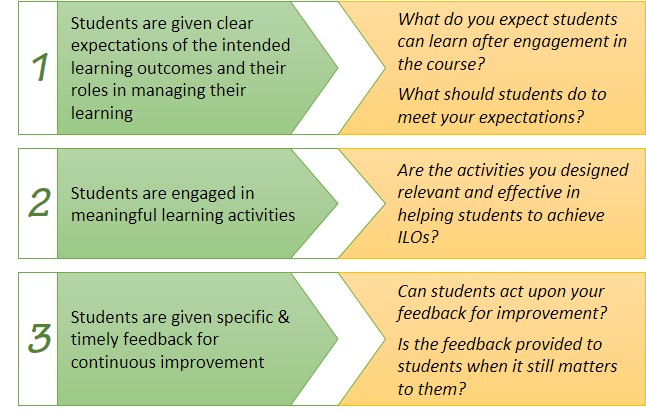Good Practice with Assessment for Learning
In a learner-centered approach to course design, successful assessment requires clear articulation of the link between assessment and the achievement of the learning outcomes and also explicitly connects to meaningful learning activities. When planning and implementing assessment activities, it is good practice to work through the following four-steps of the student learning assessment cycle:
- Define Intended Learning Outcomes: Establish clear, measurable intended learning outcomes for students
- Formulate Learning Opportunities: Ensure that students have sufficient opportunities through learning activities to achieve those outcomes
- Assess Student Learning: Systematically gather, analyze and interpret evidence to determine how well students' learning matches with your expectations
- Feed Forward of Results: Use the resulting information to understand and improve student learning

Assessment for learning has its emphasis on using assessment to promote student learning in the following ways:

9 Principles of Good Practice for Assessing Student Learning:
The American Association for Higher Education (AAHE): 9 Principles of Good Practice for Assessing Student Learning
http://www.academicprograms.calpoly.edu/pdfs/assess/nine_principles_good_practice.pdf
-
The assessment of student learning begins with educational values
-
Assessment is most effective when it reflects an understanding of learning as multidimensional, integrated, and revealed in performance over time.
-
Assessment works best when the programs it seeks to improve have clear, explicitly stated purposes.
-
Assessment requires attention to outcomes but also and equally to the experience that leads to those outcomes.
-
Assessment works best when it is ongoing not episodic.
-
Assessment fosters wider improvement when representatives from across the educational community are involved.
-
Assessment makes a difference when it begins with issues of use and illuminates questions that people really care about.
-
Assessment is most likely to lead to improvement when it is part of a larger set of conditions that promote change.
-
Through assessment, educators meet responsibilities to students and to the public.
Common Assessment Pitfalls to Avoid
Below are some common assessment pitfalls to avoid:
- the tasks do not match the stated outcomes;
- the criteria do not match the tasks or outcomes;
- the criteria are not known to students;
- students do not understand the criteria;
- overuse of one mode of assessment;
- insufficient time for students to do the assignments;
- too many assignments with the same deadline;
- insufficient time for staff to mark the assignments or examinations;
- absence of well-defined criteria so consistency is difficult to achieve;
- unduly specific criteria which create a straitjacket for students and make marking burdensome for lecturers;
- inadequate or superficial feedback provided to students;
- wide variations in marking between courses and assessors and within assessors (self-consistency);
- variations in assessment demands of different courses
- 6499 reads
